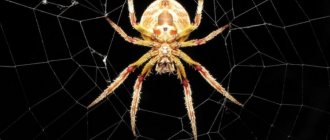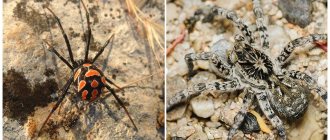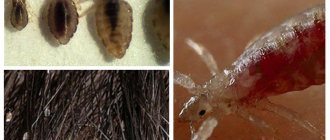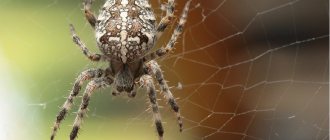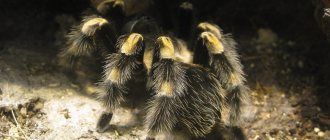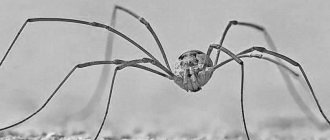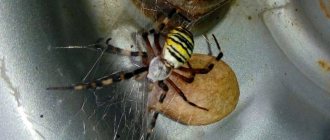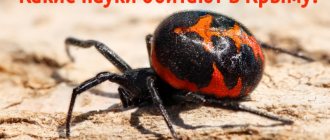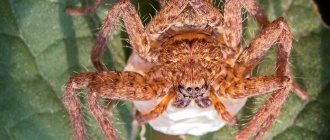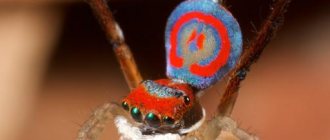Spiders of Belarus are not aware of state borders and their species set is the same: on the eastern side, the diversity of arthropods living in Russia; from the west – the composition of arachnids in Ukraine and Poland. Arachnology in Belarus is in a deplorable state. Even the number of species living there is not known for certain. According to various sources, the number of species ranges from 209 to 500. With further study, the number of arachnids is guaranteed to increase.
Types of spiders in Belarus
Since nearly 40% of the territory of Belarus is occupied by forests and swamps, and another 20% by grassy areas, the main part of the arachnofauna here is made up of forest and meadow spiders. Among the arthropods found in Belarus, there are 29 families:
- Diggers;
- Funeral;
- Haymakers;
- Brownies;
- Funnel;
- Orb weavers;
- Pygmies;
- Linifidae;
- Tenetniki;
- Tetranides;
- Anifanids;
- Cibeids;
- Dictinids;
- Khanids;
- Corinids;
- Liocranian marsupials;
- Earthen;
- Wolves;
- Oxypides;
- Hunters;
- Zorids;
- Pirates;
- Horses;
- Sparassids;
- Philodromidae;
- Sidewalkers (aka “crabs”);
- Titanosides;
- Clubionidae;
- Miturgids.
Some of these families in Belarus contain only one species, others - up to 10. The last family includes two species of Heiracanthiums. These two spiders have nothing to do with their southern counterpart. They are much smaller than yellow heyracantium and are not dangerous to humans.
On a note!
Only the silver spider can be considered a poisonous spider in Belarus.
Serebryanka
Spider from the Cybaid family. In Belarus, this family is represented only by silverfish. The second name of this species is water spider. Silver grass is widespread in Europe. Lives in bodies of water with stagnant or slow-flowing water. Catches small crustaceans swimming underwater.
Silver spider
It also spins a web underwater, using it as a diving bell for breathing. The thick stubble on its abdomen, which does not get wet, allows it to store air in its bell-shaped shelter. When the spider dives, air remains between the bristles, which the silverfish “cleans” from the abdomen into the shelter.
It overwinters underwater using the shells of dead mollusks. The silverfish attaches its air-filled shells to the duckweed. After the duckweed sinks to the bottom of the reservoir for the winter, it will drag the shell with it.
Interesting!
During hibernation, the silverfish's metabolism is greatly slowed down and there is enough air in its shell to survive the winter.
In terms of the strength of its poison, silverfish is inferior to karakurt and steatode, but it is also capable of delivering very unpleasant sensations for several hours. The spider can bite through the skin of a person in the water.
A village in the Gomel region was attacked by large tarantula spiders (video)
Large spiders attacked the Gomel region.
The problem is back! This time the insects encircled the village of Udarnoye, Lelchitsy district. Residents meet them in their gardens, barns, and today one of these uninvited guests even snuck into the house!
Akin to a horror movie script. But seriously, eyewitnesses describe the tarantulas themselves as aggressive insects that are not afraid to attack. Maxim Vecherkov went on a dangerous business trip.
It was a fight, says Nadezhda . Seeing a huge shaggy spider approaching the baby's crib, she took the firecracker. But the guest did not even think about hiding - he began to jump sharply towards him.
The woman sounded the alarm. And you didn’t even have to show proof at the bank - just a day later the same spider made its way into the local school. Teachers immediately noticed the size and unusual color.
Situations began to repeat themselves as if they were carbon copies. Spiders were seen at a local medical center, then in a store, and at a construction site. In the village the only talk is about the insect invasion. And this is the second part of the story about tarantulas.
This is 150 kilometers from Udarny. According to experts, the spiders may have been accidentally transported with cargo.
Scientists confirm that this is a real South Russian tarantula. Can reach the size of a human palm. The species itself, although rare, is still found in our southeast. And due to climate warming, their habitat is expanding and their activity is increasing.
The tarantulas most likely come from the forest. It's literally 200 meters away. Although, by their nature, due to sensitivity to any vibrations, they should be very timid: sit in burrows and lead a hidden lifestyle. But, apparently, something went wrong - these, on the contrary, are too brave.
Scientists do not know what brought them to the village and why spiders approach humans. But such behavior, they say, is truly unnatural. They urge you not to panic and stay on the defensive.
Nikolai Galinovsky , entomologist, candidate of biological sciences: “One of the methods is treatment with repellent agents or ultrasound, as is the case with an ultrasound installation for cockroaches, in a socket, you can try for spiders.” And if the situation suddenly gets out of control, the regional center will have to be involved. The village authorities say that the problem cannot be solved on their own.
Mikhail Bovsunovsky , Chairman of the Udarnensky Rural Executive Committee: “Of course, we will attract those specialists who are necessary, if these are really spiders, and even dangerous, poisonous ones, of course, measures will be taken - this is not a joke.”
Spiders are poisonous. But with a caveat. The impact on humans can be compared to the bite of a hornet. It is not fatal, but in some cases, however, a severe allergic reaction may occur. In general, there are more than ten species of large spiders that can bite through human skin in Belarus. And not all of them are harmless.
Now in Udarny, volunteers are combing the surrounding area in small groups. They are looking for nests that have begun to appear in residential areas, near the first floors of apartment buildings. For now, spiders are simply caught with bait and locked in a jar to be shown to scientists later.
Source: https://progomel.by/society/animals/2018/09/77052.html
Conditionally dangerous
These are the large spiders of Belarus from the orb weavers: Argiope Brünnich and the cross spider. The most dangerous of them is argiope, as its bite causes quite severe pain. The cross spider is considered a dangerous spider, but in reality it is not capable of biting through the skin. Fears of this species are caused by the size of the animal, although even from the photo and description the argiope should cause more concern. Bright warning coloring is usually characteristic of animals that are able to protect themselves. The female Argiope has exactly this coloration. Because of this, the animal received the nickname - wasp spider.
The cross and argiope live in similar conditions:
- parks;
- gardens;
- forest edges.
These spiders live at mid-levels and build webs on bushes and tall stems of grass.
Spiders of Belarus
A summer resident discovered a nest of tarantulas near his house • Slutsk • Newspaper “Infa-Kur'er”
A Svetlogorsk summer resident discovered a nest of tarantulas near his house in the village of Shupeiki.
He brought photos and videos of his find to the ranak editorial office on Monday. by.
“Last year, when I was mowing, I saw something big, like a mouse, running in the grass,” says Andrey. “This time I saw minks first, and then them. The first spider was even larger than this, 7-8 centimeters. And he doesn’t run away, but rears up and raises his paws...”
According to Andrey, he destroyed the dangerous insects he discovered. Another thing is that dozens of their relatives can remain in the grass.
“Unfortunately, we do not have any information on this matter,” ranak replied. by in the Svetlogorsk interdistrict inspectorate for the protection of flora and fauna and in the district environmental inspectorate.
Meanwhile, back in 2013, a researcher at the Scientific and Practical Center of the National Academy of Sciences of Belarus for Bioresources, Mikhail Maksimenkov, in an interview with the BelTA agency, said that tarantula spiders have already taken root in Belarus. According to him, South Russian tarantulas were discovered in Belarus in 2008.
Maksimenkov said that spiders began to actively spread throughout Belarus, using the floodplains of the Pripyat, Dnieper and Sozh rivers as ecological corridors.
The South Russian tarantula is an insect whose body length can reach 3.5 cm. During the day it hides in vertical burrows, and at night it goes out to hunt. Tarantulas prefer swampy meadows, live near water and feed on insects. Most often, spiders bite people who step on them through carelessness.
A tarantula spider bite is not particularly dangerous for most people, but it can cause a painful reaction and cause some swelling.
In this regard, scientists advise being vigilant when relaxing on the open, grassy banks of Pripyat and Sozh.
The danger comes from the spider's living burrows, which are covered with white cobwebs at the entrance.
Vladislav Ivanov, junior researcher at the laboratory of terrestrial invertebrate animals at the National Academy of Sciences of Belarus for Bioresources, describes Belarusian tarantulas as follows: “Females can reach five centimeters, males are half as large. This is the size of the body, excluding the legs.
Visually, it can reach eight centimeters. Like all spiders, it feeds on invertebrate animals, mainly insects. There are no recorded cases of them biting people. The bite is painful, and in case of an allergic reaction it can also be a threat to humans.
This is most dangerous for children, they may experience dizziness.”
“They live in deep burrows, 30-40 centimeters deep. They are very shy, they hide themselves if you see them,” Nikolai Galinovsky, deputy dean of the Faculty of Biology at Francisk Skorina Gomel State University, told reporters. “Its bite is like a hornet’s bite.”
Due to climate warming, in addition to tarantula spiders, other heat-loving insects, in particular the praying mantis, began to move north. If previously residents of Belarus encountered it mainly in southern countries, then in recent years photos of mantises have long been nothing new.
Kur'er wrote about the first mantises in our region back in 2010, as well as about locusts. No tarantulas have been spotted in Slutchina. Although someone may wonder: “Not noticed yet?”
PREVIOUSLY . “Belarusian nature will be saved by praying mantises, scorpions, cobras.” “Grasshopper” welcomed the Belarusian beauty with open arms, in the literal sense. And tenaciously grabbing the butterfly with his clawed paws, he bit it to death, having previously dismembered it into fragments. On a nearby branch of an apple tree, a Belarusian starling was watching what was happening...
Source: https://kurjer.info/2016/08/09/tarantul/
Diggers
In Belarus, this type of spider is represented by one species. They are also called “atypical tarantulas” or calque from Latin - atipus. Atipuses have nothing to do with real tarantulas, neither in the Russian nor in the English sense of the word.
On a note!
Mizgir, aka the South Russian Tarantula, does not live in Belarus.
The venom of atipus is weak, but they have long chelicerae with which they can bite through the skin. These spiders live in a colony. Individually they are not aggressive, but if the colony is threatened they can attack. In this case, multiple spider bites will cause harm.
Don't panic: tarantulas and praying mantises are already in Belarus
Oleg Borodin, General Director of the Scientific and Practical Center for Bioresources of the National Academy of Sciences of Belarus, told how to behave when meeting unexpected insects, as well as the causes and consequences of their appearance in the expanses of Sineokaya, in a conversation with the Green Portal.
09/08/2015 Living nature Aўtar: Denis Zelenko Photo: Oleg Tkachev, Algerd Chernyavsky
August, Mozyr district, a team of archaeologists on a country road finds a beautiful tarantula in its prime. Here and there people began to notice praying mantises.
Many look with horror at the photo with the spider, others meaningfully remark: “Climate!” Having brought all the speculations, beliefs and rumors together, we head to the Academy of Sciences, namely, to the General Director of the State Research and Production Association “Scientific and Practical Center of the National Academy of Sciences of Belarus for Bioresources” Oleg Borodin.
- What kind of invasion? - we ask him.
- This is not an invasion, tarantulas have always lived here. The first registrations of spiders were made back in 1928 in the vicinity of Rogachev. It’s just that now people are starting to see them more often. And Belarusians, due to their activity and greater environmental awareness, began to pay attention to this.
In addition, smartphones and cameras have appeared that make it possible to quickly register animals. That's why the general public learns about them. I will add that back in the 80s of the last century, our employees found wasps that parasitize precisely on these spiders.
And if there were wasps, then there were spiders.
— Where do “Belarusian” tarantulas
- In the burrows. Moreover, they put out a signal web from it, and if someone touches it, the spider jumps out and grabs the prey. As for their habitat, tarantulas are widespread in the forest-steppe zone of Eurasia, from southern Europe to China.
— Is this species dangerous for humans?
— Anything that can bite is potentially dangerous to humans. This species has powerful claw-shaped chelicerae and a toxin that can be dangerous to humans.
- Are chelicerae like jaws? I immediately remember the look of the predator from the film of the same name...
- Yes, this is a type of grasping mouthparts, modified limbs.
— Is the dose of poison not lethal for those who do not have allergies?
- It is believed that no. But from this point of view, a hornet attack is fraught with disastrous consequences for humans. Even if he doesn't have allergies. Therefore, I would not highlight the presence of poison in spiders as a terrible situation.
- What about pets? Are they in more danger?
- Yes. In the southern regions of the CIS and Central Asia, small cattle suffer. But in our conditions - and I am absolutely sure of this - the number of tarantulas is not large.
They have always been there, and since we haven’t encountered them so often, there’s no need to panic. Yes, and it’s good. On the contrary, attention should be paid to their presence in the nature of Belarus.
Like any toxic species, it is of interest to the pharmaceutical industry. For her, such spiders are raw materials.
- Okay, let's go back to the forest. If you're looking for a tarantula hole, what does it look like?
- The size of a five-kopeck coin. But it’s not easy to find: you need damp, well-warmed places. And, let me emphasize once again, it does not occur very often. And it’s not exactly a forest species.
— That is, in a forest clearing there is no threat to a person?
- No. These spiders prefer open areas closer to bodies of water. But the chances of meeting them are slim. And to the question whether the tarantula avoids humans, the answer will be unequivocal: yes, like any large object that may pose a danger. In order for a tarantula to understand what a person is in principle, it needs to have at least some kind of primitive intelligence. And this is from the realm of fantasy.
Harmless
The following families are very common in Belarus: funnelbirds, hunters, sidewalkers and horses. Besides them, you can find 4 species of wolf spiders there. Apart from family and protective coloration, these night hunters have nothing in common with the South Russian tarantula, which is also a wolf spider.
Funnel
Funnelfish live in moist, shaded places, on the forest floor, under snags and at the foot of bushes. They often settle in village houses. People gravitate toward human habitation:
- funeral;
- brownies;
- attics.
Interesting!
All these spiders build shelters in the form of funnels. They hunt woodlice, small invertebrates, and insects. In a country house, these species bring considerable benefits.
Hunters
They live on the banks of reservoirs, of which there are plenty in Belarus. There are only 3 pisaurid spiders found in the country. Spiders hunt with their hind legs on coastal vegetation and their front legs on the water surface. These hunting spiders can glide across the surface of a body of water like water striders.
On a note!
One of the pasaurids, a large alloy spider, is included in the Red Book of Belarus.
One of the most poisonous spiders in Europe was spotted in Dobrush
Before we had time to get used to the information that tarantulas had appeared in Belarus, a new poisonous spider was discovered in the south of the country. A resident of Dobrush found him near her home and took him to the Gomel University named after F. Skaryna. Specialists from the Faculty of Biology identified the spider. It turned out to be a yellow-sac spider from the genus Heiracanthium. The generic name is translated from Latin as spiny-armed, and the specific name as stinging. We contacted a scientist who specializes in the study of spiders to find out what the spiny-armed stinging spider and other spiders of this genus look like, why are they dangerous and how to avoid meeting them?
During the day, spiders hide in lairs that they weave in panicles of cereals in the meadows.
Photo provided by Evgeny Zhukovets In our country there are not many arthropods that pose a danger to humans, but you need to know about them. Evgeniy Zhukovets, a researcher at the laboratory of invertebrate animals of the State Research and Production Association “NPC for Bioresources” of the National Academy of Sciences,
commented on the dangerous find in the Gomel region:
- Judging by the photograph that I saw, we are dealing with a representative of the genus Heiracanthium. Although the individual is inanimate, slightly dried out and deformed, the species can be determined quite confidently by its massive chelicerae, or, in simple words, oral appendages. The length of the body reaches 1.5 cm. The color is dominated by yellow colors, the chelicerae are colored amber, the ends of the legs, tentacles and chelicerae are darkened to black. Heiracanthiums are nocturnal. They are active wandering hunters. They do not build networks like those that weave crosses. During the day, these spiders hide in lairs that they weave from cobwebs in panicles of cereals in meadows near water bodies or on the banks of reclamation canals. The lair is the size and shape of a table tennis ball.
These spiders prey on butterflies, aphids, caterpillars, ticks and other arthropods. Where spiders live, there are noticeably fewer garden pests. According to some reports, one individual eats more than 2,000 harmful insects per year. However, it is not for nothing that scientists have classified this species as the most dangerous spider on the European continent. Evgeny Zhukovets - about how it is dangerous for humans:
— Children most often suffer from spider bites. They are attracted to unusual white spider web balls. They tear them apart, and there is an aggressive spider. Naturally, he perceives such an intrusion into his refuge as a threat. And it stings, injecting poison. Usually in the hand. The spider easily bites through the skin of a person, especially a child. Its venom contains cytolytic substances, meaning it destroys cells. The bite is not fatal, but the bite site begins to itch, quickly swells, and turns red. Severe pain persists for up to two weeks. The consequences can be more serious, for example, if a person is allergic. How much damage you may suffer depends on your individual body.
Hairakantium punctorium lives from Portugal to Central Asia and from southern Sweden to Turkey and Greece... Since 2002, it has been recorded in the Lyuban region. Some scientists attribute this to climate warming, others explain that spiders get into the cracks of cars and thus travel considerable distances... Another representative of this genus, Hairakantium milda, has spread widely in many warm countries and is often found in human dwellings. It can often be found in hotel rooms in Greece and Turkey or in the entrances of high-rise buildings in Ukraine.
— I often saw a thorny stinging one in the Crimea and the Carpathians. In the Carpathians, he almost bit me once, but I quickly managed to shake him off my palm... In our country, these spiders mainly live in the Gomel region. In 2022, I myself observed them during a business trip in the Lelchitsy district, -
Evgeny Zhukovets shows pictures.
— The photographs were taken in October, which means the female was actively preparing for the winter.
We can see what a dense “house” she has formed from the web... Shocking information for arachnophobes - about 600 species of spiders live in Belarus. Of these, 585 are presented in the collection of samples of the Scientific and Production Center for Bioresources, which specialists from the laboratory of invertebrate animals have been building for more than 45 years. There are also tarantulas here, which have been spotted more than once in the south of the country. It is possible that the same spider that was seen in the Gomel region will soon be added to the collection. Laboratory specialists ask anyone who discovers similar finds in places atypical for Belarus to report it to them, recording the date and specific location. It is advisable to convey the find itself - live or in alcoholic form.
